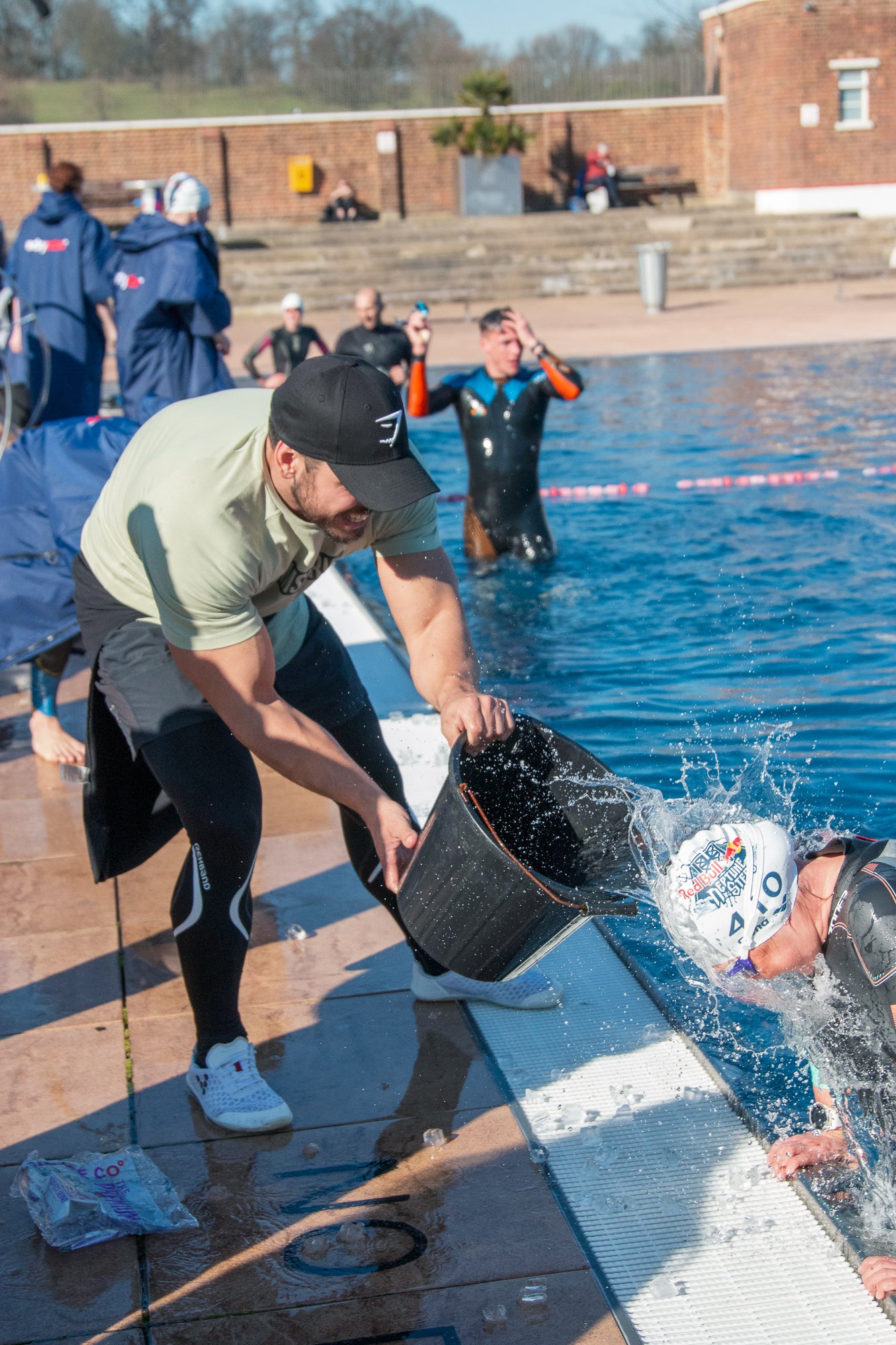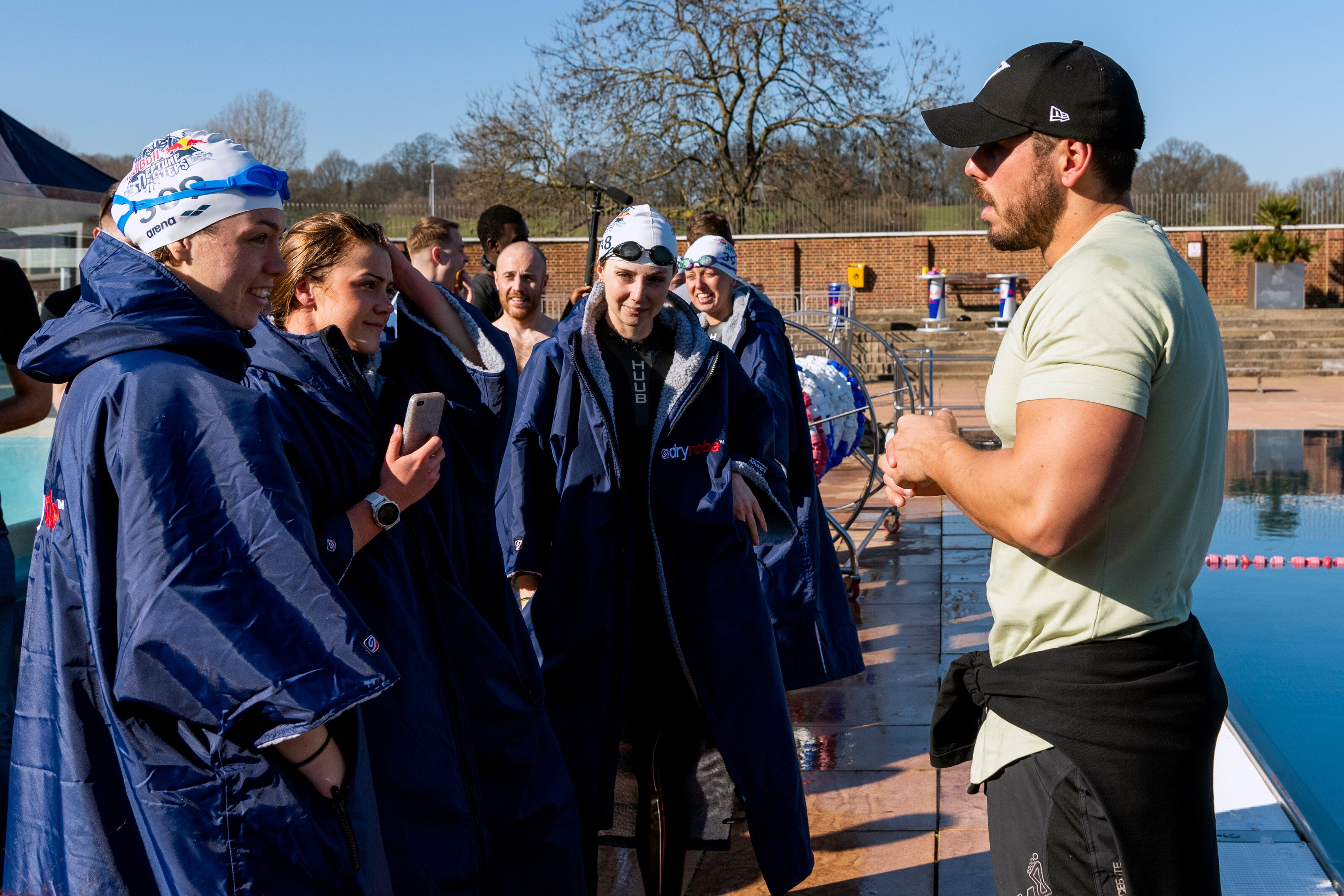9 minute read
Cold Water Swimming Tips from Ross Edgley | Expert Advice for Beginners
Dryrobe® ambassador Ross Edgley knows a thing or two about swimming in cold water.
His most recent achievement is swimming 1,000 miles around the entire coastline of Iceland over 114 days during the aptly named Great Icelandic Swim.
Before this, he became the first and currently only person to swim around Great Britain, smashing world records as he went!
Out of the water, Ross is famed for taking on extreme challenges, including swimming 40km in open water while pulling a 100-lb tree, completing a marathon pulling a Mini, and participating in the Great British Swim. Ross is also a former international athlete, having played water polo for Great Britain.
He later moved into academics of sport and graduated from the Loughborough University School of Sport and Exercise Science, writing his dissertation on the different strength and power adaptations to various training protocols.
With all of these incredible achievements under his belt, Ross seems more than qualified to share cold water swimming tips.
In our blog, Ross shares his essential cold water swimming advice. We also look at how to prepare for cold water swimming and additional cold water swimming tips from our water safety partners, the RNLI and cold water swimming coach and Olympian Keri-anne Payne.
 Why Cold Water Swimming Requires Preparation
Why Cold Water Swimming Requires Preparation
The Science Behind Cold Water Swimming
Cold-water swimming requires preparation because of the sudden drop in temperature that your body endures.
When done safely, the stress response provoked by the cold temperature triggers many biochemical and physical changes. These changes can have a positive impact both mentally and physically, which keeps cold water swimmers returning for more.
However, cold water can have a detrimental effect on the body if exposed for too long or if one is not properly acclimatised.
Educating yourself on cold water acclimatisation and cold water safety is essential. Knowing what to expect can help you acknowledge and navigate any potential threats to your safety.
Some risks to be aware of include cold water shock.
Cold water shock can change your breathing in response to experiencing a sudden drop in temperature, such as an involuntary gasp of air.
After gasping, the following reaction of concern is a rising heart rate.
When stressed, the body produces stress hormones that narrow blood vessels that serve the parts of our bodies furthest from the heart, such as hands and feet. This happens to keep the core warm and to try to reduce heat loss through the skin's surface.
As a result, blood pressure can go up, too.
A rising heart rate can also be problematic for people with previously unknown heart problems. If you have or think you may have any medical issues, it’s always advised to check with a health care professional before embarking on cold water therapy.
Reduced motor skills also occur when the body experiences low temperatures. That’s why changing into dry, warm clothing can feel challenging when you get out after swimming in cold water!
The afterdrop occurs when you return to land, when blood returns to central circulation from limbs and tissue.
This means your core body temperature continues to decrease, despite leaving the cold water. It’s essential to warm up gradually and correctly, which is why many people use a Dryrobe® for cold water swimming.
Not only is the super-warm lining of the Dryrobe® Advance changing robe designed to warm you up while wicking water away from your skin to dry you off, but its spacious design also makes changing much easier, so you can get into your clothes rapidly before getting too cold. Plus, the weatherproof outer layer means you can get changed outdoors in any conditions, whatever Mother Nature throws down.
Ross Edgley’s 4 Essential Cold Water Swimming Tips
Ross Edgley’s Top Tips for Cold Water Swimming
Anyway, enough about how to prepare for cold water swimming, back to Ross Edgley and his cold water swimming advice.
We caught up with Ross at a training session in London to prepare for Red Bull Neptune Steps, a brutal cold water challenge
Ross shares his four Cold water swimming tips to help ensure cold water safety.
There’s No Substitute for the Cold
A lot of people ask me what are tips and tricks to swimming in cold water and I always say “There’s no tips and tricks, I’m so sorry to break it to you, you’ve just got get in there! At some point, you’ve just got to put your face in!”
To quote Wim Hoff, who taught me about cold water therapy “Mother Nature and the cold, it’s merciless, but she’s also so righteous.”
There’s nowhere to hide when you are in there. You can be big, strong and a great swimmer but the cold water doesn’t care!
Understand Cold Water Shock
A lot of people when they go into cold water get a shock response, they gasp for air and they immediately say ‘Hypothermia!’. No, you’ve been in 5 seconds, it’s not hypothermia you’re experiencing cold water shock, that’s very normal. “I can’t feel my hands!” OK you’ve been in a minute and what’s happening is that all of a sudden your capillaries are vasoconstricting, they’re pulling the away blood from your extremities (your hands and feet) and pulling towards your vital organs, you’re not actually dying!
Educating yourself about cold water management means that when the cold sets in you can face it with a stoic, sports science response so you can keep calm, rather than getting in the water and panicking.
Acclimatise Before You Push
Use your time to acclimatise quickly as possible in the water, so that then interacts with your biomechanics, when swimming in pacing strategies.
You may be a good swimmer, but cold water is completely different. When you’re trying to swim in cold water that will affect your cardiorespiratory system. All of a sudden you are no longer bilaterally breathing, you’re gasping for air every other stroke.
Warm Up After Swimming
Some people don’t understand that once you get out of the water your body and your core temperature are still dropping, you are still cooling. So people get out of the water and they think they’re done and they’re not.
That’s the time you need to stick on a Dryrobe®. During the Great British Swim, I’d get out of the water, and sometimes what I would do is start hitting burpees in my Dryrobe® on the boat! People were like, “Are you not exhausted?!” And yeah, I was exhausted, but I know my temperature is still dropping, so before I’d get into bed, I’d need to warm my core temperature up!
What to Wear for Cold Water Swimming
If you’re wondering what to wear for cold water swimming, we’ve got you.
Firstly, you may be unsure if you want to swim with or skins. Skins refer to swimming without a wetsuit and wearing just a swimming costume or swimwear.
But rest assured, there are no rules regarding what to wear for cold water swimming, and it’s entirely up to you what you feel comfortable with.
It’s up to you what you want to wear in the water, and it may depend on how acclimatised you are.
In our Cold Water Swimming Guide, Olympic open water swimmer Keri-anne Payne shares her must-have cold water gear for beginners. Check it out below:
- Swimsuit
- Swim ha
- Goggles
- Woolly hat
- Booties
- Gloves
- Warm drink
- Dryrobe® Advance change robe
- Dryrobe® Changing mat

(Photo courtesy of Olaf Pignataro/ Red Bull Content Pool)
Warm clothing post-swim is essential, as this is how you safely warm up your core temperature.
The Dryrobe® Advance helps you warm up on various levels after swimming in cold water. It protects you from cold and wet weather, helps you dry off, is super warm, and can be worn as a coat after you’ve changed. Find out more about caring for your Dryrobe® here.
To get changed quickly after cold-water swimming, you’ll want warm, loose, layered clothing. A hot drink in an insulated drink container can also help warm up your body, as can a hot water bottle for extra warmth. Did you know the Dryrobe® Advance has the perfect secret inside pocket to store one?

(Photo courtesy of Harvey Gibson/Red Bull Content Pool)
Cold Water Swimming Safety Tips
Cold Water Swimming Safety: What Beginners Need to Know
If you’re new to cold water swimming, there are safety aspects you must consider, as there are potential risks.
Here are some of the most important cold water safety tips. For an in-depth look, please visit our Benefits of Cold Water Swimming guide.
- Firstly, as Ross has explained in his 4 Essential Cold Water Swimming Tips above, understanding cold water shock is necessary. Educating yourself on this will ensure you don’t panic when experiencing cold temperatures.
- Make sure you acclimatise properly. See Ross’ cold water acclimatisation advice above or see the advice from our water safety partners, the RNLI, here.
- Always swim with others. Not only is it great socially, but it’s also vital to have another person around should an emergency occur.
- If you really can’t take a swimming buddy, tell someone the location of your swim and an estimated time for how long you plan to be.
- A brightly coloured tow float and swim cap is also essential so other people in the water can spot you, especially if you plan to swim rather than dip.
- Choose a safe location, ideally on a red and yellow flagged beach.
- ‘If in doubt, don’t go out.’ Check the weather conditions and water temperature before swimming, and don’t swim if the conditions are dangerous or too cold.
- Be aware of currents and tides.
Find out more cold water safety advice from the RNLI here.
In short, Ross Edgley’s cold water tips are:
- The only way to face the cold is to face the cold; there’s no substitute or quick tricks.
- Get educated about cold water shock.
- Make sure to acclimatise properly.
- Prepare to warm up with ease after swimming.
Start small and slow, and grow your exposure to cold water over time.
Follow Ross:
Instagram: @rossedgley
YouTube: @RossEdgley
TikTok: @rossedgley
Facebook: Ross Edgley
X: @RossEdgley
#dryrobeterritory
Published on March 21, 2019
